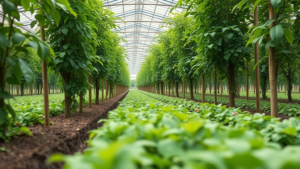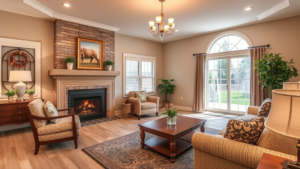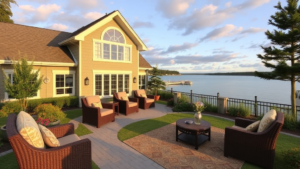Green Assisted Living Facilities

The Benefits of Green Assisted Living Facilities for Seniors
As the demand for quality living spaces increases, many families are considering green assisted living facilities for their elderly loved ones. These facilities prioritize sustainability while offering a range of services that cater to seniors’ needs. This approach combines comfort, care, and environmental responsibility, providing numerous benefits for both residents and the planet.
One of the most compelling advantages of green assisted living facilities is their focus on health and wellness. By utilizing natural materials and including eco-friendly designs, these facilities create a healthier environment for seniors. Studies show that exposure to natural light and outdoor spaces can significantly boost mood and overall well-being. Enjoying gardens, walking trails, and green areas encourages physical activity, which is essential for maintaining mobility and vitality in older adults.
Additionally, energy-efficient appliances contribute to reduced utility costs and a smaller carbon footprint. Most green assisted living facilities use energy-saving technologies, such as solar panels and efficient heating and cooling systems. By utilizing these resources, they often pass cost savings on to residents, making the living environment more affordable.
An engaging community feeling is vital for seniors, and many green assisted living facilities promote social interaction through communal spaces. Whether it’s cooking classes using organic ingredients or gardening projects that allow residents to bond over shared interests, these programs foster connections. As a result, seniors often experience reduced feelings of isolation and depression, enhancing their overall quality of life.
- Sustainable Practices: Facilities focus on recycling, composting, and reducing waste, teaching residents about eco-friendly habits.
- Nutritious Meals: Many green assisted living facilities emphasize farm-to-table dining, prioritizing fresh, organic produce and home-cooked meals.
- Physical Activity: Outdoor spaces and green areas provide opportunities for exercise and relaxation, encouraging a healthier lifestyle.
Another important benefit is the impact on family peace of mind. Knowing that their loved ones are living in a facility that values green practices allows families to feel secure in their choice. They are confident that their elders are not only receiving the care they need but also living in an environment that promotes health and sustainability.
| Benefit | Description |
|---|---|
| Health and Wellness | Reduced stress and improved mood through natural surroundings and light. |
| Cost Savings | Lower utility bills due to energy-efficient technologies. |
| Social Engagement | Enhanced community connections through group activities. |
| Environmental Responsibility | Commitment to sustainability benefits the planet. |
Additionally, green assisted living facilities often incorporate technology that supports aging in place. Smart home devices can assist with daily tasks, monitor health, and even remind residents to take medications. These technologies allow seniors to maintain their independence while providing peace of mind to their families.
The demand for eco-conscious living options is growing rapidly. With more facilities adopting green initiatives, seniors have access to enhanced living conditions that align with modern values. Choosing a facility that prioritizes sustainable practices is not just a decision for the individual but also a commitment to the future health of our planet.
As families explore options for their loved ones, it’s crucial to consider all available resources. For additional information and resources related to green assisted living, visit Green Seniors, offering insights into sustainable living solutions for older adults.
Green assisted living facilities present numerous benefits, combining health, social interaction, and cost-effectiveness with a commitment to sustainability. This unique approach to senior living not only enhances the quality of life for residents but also contributes positively to the environment. In making a decision on long-term care, choosing such a facility offers an invaluable opportunity for seniors to thrive as they age.
Sustainable Practices in Assisted Living: A Closer Look
Green assisted living facilities are transforming the way we think about care for the elderly. These sustainable spaces not only prioritize the health of their residents but also embrace eco-friendly practices that benefit the environment. By incorporating innovative solutions, these facilities create a harmonious balance between care and sustainability.
One of the key components of green assisted living is energy efficiency. These facilities often use renewable energy sources like solar panels, wind energy, and geothermal heating. This helps lower their carbon footprint and reduce energy costs. Imagine living in a place that not only cares for you but also contributes positively to the planet.
Water conservation is another essential aspect. Facilities incorporate systems such as rainwater harvesting and low-flow fixtures to minimize water waste. These practices ensure that every drop counts while providing all the necessary amenities for residents. Residents enjoy gardens and landscapes that thrive thanks to these sustainable methods.
Waste management is a crucial consideration in these green facilities. They often implement thorough recycling programs and composting systems. This reduces landfill waste significantly and teaches residents about the importance of sustainable living. Here are some common waste management practices:
- Separate bins for recyclables and compostables
- Education programs about waste reduction
- Partnerships with local farms for organic waste disposal
Green assisted living facilities are also focused on sourcing sustainable food. Many of these homes emphasize farm-to-table dining experiences. They partner with local farmers to provide fresh, organic produce and reduce their carbon footprint associated with transportation. This not only results in healthier meal options but also supports the local economy.
Environmental awareness is promoted throughout the community. Many facilities engage residents in gardening or sustainability projects. These activities not only enhance mental health through interaction with nature but also keep residents active and engaged, promoting a better quality of life.
Indoor environments in these facilities prioritize indoor air quality. They avoid using harmful chemicals in cleaning supplies and incorporate green building materials. This results in healthier living spaces, which is especially crucial for elderly residents. Good air quality can reduce respiratory issues and other health concerns, making the environment more comfortable.
Transportation options also reflect sustainable practices. Some facilities provide electric shuttles or encourage carpooling to reduce emissions. For residents, this means easier access to local attractions or grocery stores without relying heavily on conventional gas-powered vehicles.
In addition to all these practices, the design and layout of these facilities often emphasize natural light and green spaces. Large windows, open floor plans, and communal gardens create an inviting atmosphere. This helps foster a sense of community while also providing spaces for residents to enjoy nature.
Many innovative technologies are being introduced in green assisted living environments. Smart home technologies, like energy monitoring systems and automated lighting, enhance efficiency and comfort. Residents can engage with these tools, making them feel empowered in their living space.
Caring for the elderly with a sustainable mindset not only enhances their quality of life but sets a vital example for future generations. More facilities are realizing that eco-friendly practices are not just trends; they are essential commitments to community health and well-being.
With the increasing demand for green assisted living facilities, it’s essential to provide resources for families seeking the best care options. For more information about sustainable practices in assisted living, you might want to visit Green Assist or explore community-driven solutions at Sustainable Seniors.
The future of assisted living lies in these sustainable practices. As more facilities adopt these methods, we can expect to see a positive impact not only on residents’ lives but also on the environment. It’s an exciting time for communities to embrace a greener, healthier approach to elder care.
How Green Assisted Living Enhances Resident Well-Being
Choosing the right living environment for seniors is crucial. While families look for comfort and care, many are now considering the environmental impact of their choices. Green assisted living facilities have recently emerged as a popular option. These communities focus on eco-friendliness while promoting the well-being of residents. They combine sustainable practices with a healthy lifestyle, creating a nurturing atmosphere.
Green assisted living facilities offer several benefits that contribute to the overall well-being of their residents. Let’s take a look at some of these benefits:
- Sustainable Design: Many green assisted living facilities are designed with energy-efficient materials. This not only reduces the carbon footprint but also creates a comfortable living space. Features such as natural lighting, ventilation, and energy-efficient appliances create a pleasant atmosphere.
- Outdoor Spaces: These facilities prioritize the connection with nature. Gardens, walking paths, and green spaces encourage residents to spend time outdoors. This exposure to fresh air and sunlight contributes to mental and physical health.
- Healthier Food Options: Green assisted living communities often focus on offering organic and locally sourced meals. A diet rich in fresh fruits, vegetables, and whole grains can significantly impact a resident’s health. Many facilities also offer activities such as gardening, allowing residents to grow their own food.
- Social Activity Programs: Green facilities promote community engagement through various programs. Activities like yoga, nature walks, and eco-friendly craft workshops not only keep residents physically active but also foster social connections.
These elements of green assisted living work together to enhance resident well-being. They create an environment where seniors can thrive both physically and emotionally.
Another vital aspect of these facilities is how they address mindfulness and mental health. In today’s busy world, many elderly individuals can feel isolated. Green assisted living emphasizes community building and creates opportunities for social interaction. When residents engage in group activities related to the environment, it fosters a sense of belonging and purpose.
Sustainability practices also play a role in promoting mental wellness. Knowing that they are in a facility that cares for the environment can uplift residents’ spirits. This sense of purpose can significantly enhance their quality of life. For more information on the mental health benefits associated with green living, you can refer to this source.
Costs can sometimes be a concern when considering specialized living facilities. However, green assisted living can lead to savings in energy bills. Many facilities take advantage of renewable energy sources, which lower overall operating costs. These savings can sometimes be passed on to residents, ensuring they receive high-quality care without breaking the bank.
Not all assisted living options are equal in terms of green practices. It’s essential to research facilities to find those that genuinely commit to sustainability. Look for certifications like LEED (Leadership in Energy and Environmental Design) which indicates a facility meets strict environmental standards. The commitment to sustainability plays a pivotal role in residents’ overall happiness and well-being.
| Benefits of Green Assisted Living | Description |
|---|---|
| Sustainable Design | Energy-efficient materials that create a comfortable living space. |
| Outdoor Spaces | Gardens and walking paths that encourage outdoor activities. |
| Healthier Food Options | Focus on organic, locally sourced meals for better health. |
| Social Activity Programs | Engaging programs that promote physical and mental well-being. |
| Mental Wellness | Community engagement reduces isolation and fosters purpose. |
In essence, green assisted living facilities bring many advantages to their residents. From improved mental health to eco-friendly practices, these communities prioritize the overall well-being of seniors. They represent an excellent choice for families looking for compassionate care in a sustainable environment.
For those interested in exploring options further, facilities like GreenCare offer extensive resources on green assisted living choices. Discover how choosing the right living environment can impact your loved one’s life positively.
Renewable Energy Solutions in Senior Living Communities
As the global emphasis on sustainability continues to grow, many senior living communities are looking for ways to incorporate renewable energy solutions. This move not only benefits the environment but also enhances the quality of life for residents. Adopting renewable energy technologies can lead to reduced utility costs and an improved living experience. Here is a closer look at how senior living facilities are integrating renewable energy.
The Importance of Renewable Energy in Senior Living
Renewable energy is crucial for several reasons:
- It reduces greenhouse gas emissions, promoting a cleaner environment.
- By lowering energy costs, facilities can allocate more resources to resident activities and services.
- Seniors benefit from a stable power supply, ensuring safety and comfort in their homes.
Solar Power Solutions
Solar energy is becoming a leading choice for senior living communities. Here’s why:
- Cost-Effective: Solar panels can significantly reduce electricity bills, saving money for the community.
- Low Maintenance: Once installed, solar panels generally require minimal maintenance.
- Grid Independence: This energy source can provide power even during outages, allowing residents more security.
Wind Energy Utilization
Wind turbines are another renewable energy source that some senior living communities are beginning to explore. Benefits include:
- Space Efficiency: Many wind turbines can be installed on smaller plots, making them ideal for senior living settings.
- Long Lifespan: Wind turbines can operate for decades, generating years of sustainable energy.
Geothermal Heating and Cooling
Many facilities are also looking at geothermal systems as a viable option:
- Energy Efficiency: Geothermal heat pumps use significantly less electricity than traditional systems.
- Comfort: This solution provides consistent temperature control, making living spaces comfortable year-round.
Power Purchase Agreements (PPAs)
Communities often utilize Power Purchase Agreements to finance renewable energy projects. Through these agreements, they can:
- Access advanced renewable technologies without up-front costs.
- Stabilize energy pricing, which can benefit budgeting and financial planning.
Benefits for Residents
Renewable energy solutions brings numerous benefits for residents:
- Health and Wellness: A sustainable environment often correlates with better health outcomes for seniors.
- Community Engagement: Many facilities involve residents in sustainability initiatives, boosting morale and community bonding.
Case Studies of Successful Implementation
Several senior living communities are leading the way in implementing renewable energy solutions:
| Community Name | Renewable Source | Year Implemented | Annual Cost Savings |
|---|---|---|---|
| Sunny Acres | Solar | 2021 | $15,000 |
| Green Springs | Geothermal | 2020 | $10,000 |
| Breezy Hills | Wind | 2019 | $18,000 |
These communities showcase the tangible benefits of adopting renewable energy solutions. Not only do they create a sustainable living environment, but they also provide financial relief that can be directed towards improving resident experiences.
Resources for Senior Living Communities
If you’re interested in learning more about renewable energy in senior living communities, check out the following resources:
Integrating renewable energy solutions in senior living communities can create a healthier, more sustainable environment for aging adults. By understanding and evaluating these options, communities can position themselves not only as care providers but also as innovators in promoting sustainability and quality of life.
Choosing the Right Green Assisted Living Facility for Your Loved One
Finding the right place for your loved one can be a challenging journey, especially when considering a green assisted living facility. These facilities focus on environmentally friendly practices while providing quality care. To help you navigate this process, here are some key factors to consider when choosing a green assisted living facility.
Understanding Green Assisted Living
Green assisted living facilities are designed to provide comfortable living environments that incorporate sustainable practices. They prioritize energy efficiency, reducing waste, and promoting wellness for residents. Here are some elements that define green living:
- Use of renewable energy sources, such as solar panels.
- Water conservation systems to minimize consumption.
- Healthy and locally sourced food options.
- Eco-friendly materials used for construction and furnishings.
Assessing Location and Environment
The location of a green assisted living facility plays a crucial role in the well-being of residents. Consider the following:
- The facility’s proximity to nature, parks, and walking trails.
- Access to public transportation and community resources.
- The overall air quality and noise levels in the area.
Evaluating Care Options
Care services vary across facilities, so it’s essential to assess what is offered. Look for:
- Personalized care plans that address individual needs.
- Available medical assistance and wellness programs.
- Social engagement activities that promote community bonding.
Exploring Sustainability Practices
Since sustainability is at the core of green assisted living, ask potential facilities about their practices. These may include:
- Refuse and recycling programs to minimize waste.
- On-site gardens or community-sponsored gardening programs.
- Partnerships with local farms for fresh produce.
Inspecting Amenities and Services
The facilities should offer amenities that enhance quality of life. Consider these aspects:
- Comfortable living spaces that utilize natural lighting.
- Opportunities for physical activities such as yoga or walking clubs.
- Access to technology that helps residents stay connected with family.
Financial Considerations
Affordability can significantly affect your decision. It is crucial to thoroughly research and understand the financial commitments involved. Here are some tips:
- Ask about payment options, including insurance coverage.
- Look for grants or financial assistance programs that may be available.
- Evaluate the cost of additional services that may not be included in the base fee.
Visiting Facilities
After narrowing down your options, visiting the facilities is essential. Pay attention to:
- The cleanliness and atmosphere of the living spaces.
- Interactions between staff and residents.
- Responses to your questions about care and sustainability practices.
Engaging with Current Residents and Families
One of the best ways to gauge a facility’s quality is to talk to current residents and their families. They can provide insights about:
- The quality of care and support they receive.
- The involvement of staff in daily activities.
- Overall satisfaction with the living environment.
Making a Decision
After thoroughly evaluating potential facilities based on the factors listed, you should have a much clearer picture of which green assisted living facility may be the best fit. Ensure that you prioritize your loved one’s preferences and needs while weighing the available options. This decision will impact their quality of life for years to come.
For more information on sustainable assisted living, consider visiting sources like Green Home Institute and Aging In Place for valuable insights and guides.
| Facility Feature | Importance |
|---|---|
| Energy Efficiency | Reduces overall costs for the facility and residents |
| Local Food Options | Improves nutrition and supports local agriculture |
| Waste Reduction Programs | Promotes sustainability and eco-friendly practices |
Choosing a green assisted living facility is an important step in ensuring a healthy, sustainable, and comfortable lifestyle for your loved one. By evaluating all of the factors mentioned above, you can make an informed decision that benefits not only your family member but also the environment.



